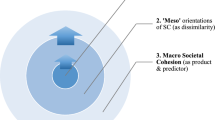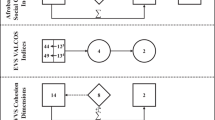Abstract
This paper aims to present a theoretically based, multidimensional and comparable measurement of social cohesion, applicable in 47 European countries/regions using the most recent micro-level data of the European Value Study (EVS) from 2008 that build upon the previous research conducted on the EVS data from 1999 covering 33 countries. The analysis is conducted in five steps. In the first part, we create a set of measurable intermediate indicators that correspond to the social cohesion dimensions suggested by the theory. In the second part, we verify whether these indicators empirically corroborate the multidimensional structure of the concept proposed by the theory. The third part examines whether the obtained intermediate indicators of social cohesion form the same constructs across countries and whether they can yield a cross-country equivalent measure of social cohesion. In the fourth step, composite scores of all dimensions of social cohesion are calculated for all analysed countries/regions. The last step shows a practical application of the obtained indices and compares levels of social cohesion in six broader geographical regions of Europe to demonstrate the applicability of the measurement in comparative research.





Similar content being viewed by others
Notes
The selection of items for our analysis was guided by the theoretical framework (Table 1). One could, for example, try to include trust in fellow citizens/interpersonal trust as one of the indicators of social cohesion. However, in Bernard’s view (Bernard 1999), formal/attitudinal domain of social cohesion consists of two dimensions: legitimacy and acceptance. The concept of legitimacy concerns various social institutions and not individuals as such. The acceptance dimension is defined by the author as acceptance of differences rather than interpersonal trust. Thus, this indicator was disregarded in this paper. However, further research could verify what are the links between interpersonal trust and here suggested indicators of social cohesion.
In the paper, we follow the definition of informal solidarity provided by Van Oorchot (2000) and Van Oorchot et al. (2005) stating that informal solidarity refers to people’s feelings about and concerns with the weaker and disadvantaged groups of the population including immigrants. This definition matches in our view the Bernard’s theoretical claim that the acceptance dimension of social cohesion is represented by the acceptance of differences. Besides informal solidarity, we decided to include in the operationalization of the term of acceptance people’s concern with other individuals living in different proximity.
Classical EVS indicators of social distance/tolerance asking respondents which groups they would not like as their neighbour was not used to measure acceptance because we cannot guarantee functional invariance among analyzed countries. The connotation of Muslims, Christians, homosexuals, people with large families, right and left wing extremists etc. might vary significantly among countries as we have for example Muslim and transitional (post-soviet) countries in our sample.
Economic domain of social cohesion proposed by Bernard (1999) not included in the study due to earlier mentioned reasons (see page 3).
References
Acket, S. (2010). Cohésion sociale et indicateurs macro [Social cohesion and macro indicators], Documents techniques no 2010–21. Differdange: CEPS/INSTEAD.
Acket, S., Borsenberger, M., Dickes, P., & Sarracino, F. (2011). Measuring and validating social cohesion: A bottom-up approach. Luxembourg: CEPS/INSTEAD, Working Paper no. 2011-08, Paper presented at the International Conference on Social Cohesion and Development. OECD, Paris, 20/02/2011–21/02/2011.
Bernard, P. (1999) La Cohésion sociale: Critique d’un quasi-concept [Social cohesion: Critique of a quasi-concept], Lien social et Politiques. RIAC, 41, 47–59.
Borg, I., & Groenen, P. J. (2005). Modern multidimensional scaling. New York: Springer.
Borg, I., & Shye, S. (1995). Facet theory. Form and content. Thousand Oaks: Sage Publications.
Canter, D. E. (1985). Facet theory: Approaches to social research. New York: Springer.
Carroll, J. D., & Chang, J. J. (1970). Analysis of individual differences in multidimensional scaling via an N-way generalization of Eckart-Young decomposition. Psychometrika, 35, 238–319.
Chan, J., To, H., & Chan, E. (2006). Reconsidering social cohesion: Developing a definition and analytical framework for empirical research. Social Indicators Research, 75, 273–302.
Cortina, J. M. (1993). What is coefficient alpha? An examination of theory and applications. Journal of Applied Psychology, 78, 98–104.
Coxon, A. P. M. (1982). The user’s guide to multidimensional scaling. London: Heinemann.
Dickes, P. (2010). Mesure de la cohésion sociale dans l enquête EVS 2008-47 pays [Measuremetn of social cohesion using EVS survey 2008-47 countries]. Document Technique no. 2010-27, Differdange: CEPS/INSTEAD.
Dickes, P., Valentova, M., & Borsenberger, M. (2008). Social cohesion: Measurement based on the EVS micro data. Statistica Applicata, 20(2), 1–16. Paper presented at the Conference of New Techniques and Technologies for Statistics. Eurostat, Brussels, 18/02/2009–20/02/2009.
Dickes, P., Valentova, M., & Borsenberger, M. (2010). Construct validation and application of a common measure of social cohesion in 33 European countries. Social Indicators Research, 98, 451–473.
Dickes, P., Valentova, M., & Borsenberger, M. (2011). A multidimensional assessment of social cohesion in 47 European countries. CEPS/INSTEAD Working Papers no. 2011-07.
EVS. (2012). http://www.europeanvaluesstudy.eu/evs/about-evs/. Accessed February 15, 2012.
Fahey, T., Hayes, B. C., & Sinnott, R. (2006). Conflict and Consensus A study of values and attitudes in the Republic of Ireland and Northern Ireland. Leiden-Boston: Brill.
Fox, J. A., & Tracey, P. E. (1986). Randomized response: A method for sensitive surveys. London: Sage Publication.
Galland, O. (2002). Les dimensions de la confiance. Futuribles, 277, 15–39.
GESIS. (2012). http://zacat.gesis.org/webview/index.jsp?object=http://zacat.gesis.org/obj/fCatalog/Catalog5. Accessed February 28, 2012.
Green, A., Janmaat, J. G., & Han, C. (2009). Regimes of social cohesion. LLAKES Centre Research Paper Series. Available at: http://www.llakes.org/wp-content/uploads/2010/08/Z.-Regimes-of-Social-Cohesion.pdf.
Halman, L., & Vloet. A. (1994). Measuring and comparing values in 16 countries of the Western World in 1990 and 1981/WORC (Work and Organization Research Group). Tilburg: Tilburg University.
Halman, L., Luijkx, R., & van Zundert, M. (2005). Atlas of European values. Tilburg: Brill, Tilburg University.
Janmaat, J. G. (2011). Social cohesion as a real-life phenomenon: Assessing the explanatory power of the universalist and particularist perspectives. Social Indicators Research, 100(1), 61–83.
Jöreskog, K. G., & Sörbom, D. (1993). Lisrel 8: Structural equation modelling with the SIMPLIS command language. Hillsdale: Lawrence Erlbaum Associates.
Kruskal, J. B., & Wish, M. (1978). Multidimensional scaling. London: Sage Publications.
Listhaug, O. (1995). The impact of modernization and value change on confidence in institutions. In R. de Moor (Ed.), Values in Western societies (pp. 167–177). Tilburg: Tilburg University Press.
Petterson, T. (2008). Changing Swedish civic orientations from solidarity to activism? In T. Petterson & Y. Esmer (Eds.), Changing values. Persisting cultures (pp. 123–148). Leiden-Boston: Brill.
Tournois, J., & Dickes, P. (1993). Pratique de l’échelonnement multidimensionnel [Practice of multidimensional scaling]. Brussels: De Boeck University.
Van Oorchot, W. (2000). Who should get what and why? On deservingness criteria and the conditionality of solidarity among the public. Policy and Politics, 28(1), 31–46.
Van Oorchot, W., Arts, W., & Halman, L. (2005). Welfare state effects on social capital and informal solidarity in the European Union: Evidence from the 1999/2000 European Value Study. Policy and Politics, 33(1), 33–54.
Acknowledgments
This research is part of the VALCOS project supported by the Luxembourg ‘Fonds National de la Recherche’ (contract FNR/VIVRE/06/01/09) and by core funding for CEPS/INSTEAD from the Ministry of Higher Education and Research of Luxembourg. We would like to thank to Sylvain Acket, Monique Borsenberger, Charles Fleury and Francesco Sarracino for their contribution to the creation of the measurement of social cohesion.
Author information
Authors and Affiliations
Corresponding author
Appendix
Rights and permissions
About this article
Cite this article
Dickes, P., Valentova, M. Construction, Validation and Application of the Measurement of Social Cohesion in 47 European Countries and Regions. Soc Indic Res 113, 827–846 (2013). https://doi.org/10.1007/s11205-012-0116-7
Accepted:
Published:
Issue Date:
DOI: https://doi.org/10.1007/s11205-012-0116-7




